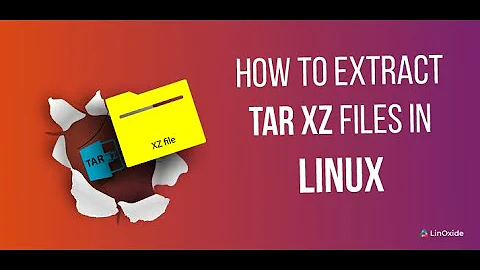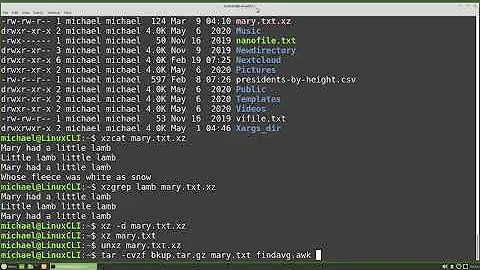Create a tar.xz in one command
Solution 1
Use the -J compression option for xz. And remember to man tar :)
tar cfJ <archive.tar.xz> <files>
Edit 2015-08-10:
If you're passing the arguments to tar with dashes (ex: tar -cf as opposed to tar cf), then the -f option must come last, since it specifies the filename (thanks to @A-B-B for pointing that out!). In that case, the command looks like:
tar -cJf <archive.tar.xz> <files>
Solution 2
Switch -J only works on newer systems. The universal command is:
To make .tar.xz archive
tar cf - directory/ | xz -z - > directory.tar.xz
Explanation
tar cf - directoryreads directory/ and starts putting it to TAR format. The output of this operation is generated on the standard output.|pipes standard output to the input of another program...... which happens to be
xz -z -. XZ is configured to compress (-z) the archive from standard input (-).You redirect the output from
xzto thetar.xzfile.
Solution 3
If you like the pipe mode, this is the most clean solution:
tar c some-dir | xz > some-dir.tar.xz
It's not necessary to put the f option in order to deal with files and then to use - to specify that the file is the standard input. It's also not necessary to specify the -z option for xz, because it's default.
It works with gzip and bzip2 too:
tar c some-dir | gzip > some-dir.tar.gz
or
tar c some-dir | bzip2 > some-dir.tar.bz2
Decompressing is also quite straightforward:
xzcat tarball.tar.xz | tar x
bzcat tarball.tar.bz2 | tar x
zcat tarball.tar.gz | tar x
If you have only tar archive, you can use cat:
cat archive.tar | tar x
If you need to list the files only, use tar t.
Solution 4
Quick Solution
tarxz() { tar cf - "$1" | xz -4e > "$1".tar.xz ; }
tarxz name_of_directory
(Notice, not name_of_directory/)
Using xz compression options
If you want to use compression options for xz, or if you are using tar on MacOS, you probably want to avoid the tar -cJf syntax.
According to man xz, the way to do this is:
tar cf - filename | xz -4e > filename.tar.xz
Because I liked Wojciech Adam Koszek's format, but not information:
-
ccreates a new archive for the specified files. -
freads from a directory (best to put this second because-cf!=-fc) -
-outputs to Standard Output -
|pipes output to the next command -
xz -4ecallsxzwith the-4ecompression option. (equal to-4--extreme) -
> filename.tar.xzdirects the tarred and compressed file tofilename.tar.xz
where -4e is, use your own compression options.
I often use -k to --keep the original file and -9 for really heavy compression. -z to manually set xz to zip, though it defaults to zipping if not otherwise directed.
To uncompress and untar
To echo Rafael van Horn, to uncompress & untar (see note below):
xz -dc filename.tar.xz | tar x
Note: unlike Rafael's answer, use xz -dc instead of catxz. The docs recommend this in case you are using this for scripting. Best to have a habit of using -d or --decompress instead of unxz as well. However, if you must, using those commands from the command line is fine.
Solution 5
I can never remember which archive switch does what, so these days, I prefer the "auto-compress" feature in newer tar versions (-a or --auto-compress). The command then simply looks like this:
tar caf file.tar.xz file
With that -a option, tar deduces the compression to use automatically from the file ending used for the archive!
Related videos on Youtube
George K.
Updated on December 03, 2021Comments
-
George K. over 2 years
I am trying to create a
.tar.xzcompressed archive in one command. What is the specific syntax for that?I have tried
tar cf - file | xz file.tar.xz, but that does not work. -
 Engineer2021 about 10 years+1 On RHEL 5.10, I don't see a
Engineer2021 about 10 years+1 On RHEL 5.10, I don't see aJoption, but this works. I think you need RHEL6. -
Eliah Kagan about 9 years
-fdoes not mean "from file" when passed toxz. Instead it is short for--force(see xz(1) for details), and is best not used unless needed. -
Stuart Cardall over 8 yearsadding
vto the command switches (tar -cJvf) to be verbose shows the files being added to the archive. -
mwfearnley over 7 yearsWhy not adjust the commands to pipe the output from tar to xz?
-
mwfearnley over 7 yearsGiven the ordering is important with the dash, it's probably best to assume the ordering is always important, and put the
flast, even without the dash. -
chmike about 7 yearsIs it possible to pass xz parameters like -e (--extended) ? Apparently it wont use extended by default.
-
Jack Q over 6 years@mwfearnley I think the note is merely to emphasize that the commands required to be executed sequentially. Since the file name is used in both command, they won't write or read data from standard output or input. If using the command without specifying the filename, they can be chained up, like
tar -c file-to-compress | xz -z > file.tar.xz. -
Wojciech Adam Koszek over 6 years@EliahKagan Fixed. Thanks.
-
cbarrick about 6 years
taron macOS seems to support-Jbut the feature is not given in the man page. Had to look it up here. Though they do mention XZ in the section on--options... -
Lo-Tan over 5 yearsAny particular reason for not using the
tar -cJfsyntax on MacOS? Just curious, because I was doing that just now and it seemed to be working. -
 Connor over 5 years@Lo-Tan It works if you have tar. When I was using it I didn't have the right version of tar so it didn't work for me. I also wanted to use the compression options for xz, which you can't do if you use tar. Also, the piping syntax is easier for me to remember, so I tend to use that. But to each their own
Connor over 5 years@Lo-Tan It works if you have tar. When I was using it I didn't have the right version of tar so it didn't work for me. I also wanted to use the compression options for xz, which you can't do if you use tar. Also, the piping syntax is easier for me to remember, so I tend to use that. But to each their own -
oidualc over 5 yearsTo use multithreaded compression the option -T0 can be used:
tar cf - directory/ | xz -z -T0 - > directory.tar.xz -
 fgwaller over 5 yearsAnother advantage is that you can easily specify the compression level or any other option to xz on the command line. For example if you want to speed up the compression and do not care that much about the size you can use
fgwaller over 5 yearsAnother advantage is that you can easily specify the compression level or any other option to xz on the command line. For example if you want to speed up the compression and do not care that much about the size you can use-1 -T0or-0 -T0as options, which will usually still give you a smaller file than gzip in a comparable or faster time, while the default-6is considerably slower than gzip. -
 Luis Lavaire. almost 4 yearsUsing
Luis Lavaire. almost 4 yearsUsing&will not launch a command one after another. Instead, it will launch the first one as a background process. -
 Dzenly almost 4 years@chmike Use XZ_OPT environment variable. E.g. XZ_OPT="-9e -T0".
Dzenly almost 4 years@chmike Use XZ_OPT environment variable. E.g. XZ_OPT="-9e -T0". -
Phillip Schmidt over 3 yearsYou probably mean
&&, which runs commands sequentially. It also stops executing if any of the individual commands returns an error code
![How to Extract tar.xz file Using command in Ubuntu [Zero One]](https://i.ytimg.com/vi/6DQ-i2WlPUU/hq720.jpg?sqp=-oaymwEcCNAFEJQDSFXyq4qpAw4IARUAAIhCGAFwAcABBg==&rs=AOn4CLDpFo7Lgi88KvoZPPI1U-soqYoMBA)
![How to create,extract,compress tar files in linux ubuntu [ Explained ]](https://i.ytimg.com/vi/nxor30XUqnU/hq720.jpg?sqp=-oaymwEcCNAFEJQDSFXyq4qpAw4IARUAAIhCGAFwAcABBg==&rs=AOn4CLAI1HQ5BFSNoJH1hC_FqiK-sFhSAg)




